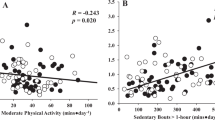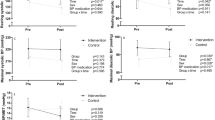Abstract
The accumulation of intermittent bouts of physical activity (PA) has been found to reduce blood pressure (BP) in prehypertension and hypertension. Yet, the BP response among several short sessions within the accumulation of PA in a single day has not been examined. The purpose of the study was (1) to investigate the BP reduction during the rest periods following three successive 10-min walking sessions accumulated over a 3-h period in prehypertensive adults and (2) to observe the role of autonomic modulation during the rest periods following each short PA session. Adults with prehypertension (131.9±4.7/82.5±6.4 mm Hg) participated in the study. BP using ambulatory monitoring and autonomic modulation through heart rate variability (HRV) using Holter monitoring were measured at baseline and during the rest periods following three short sessions (three 10-min treadmill walks at 50% of peak oxygen uptake (VO2peak); at least 50 min apart) over a 3-h period. Variables of BP and autonomic modulation were averaged for the baseline and for the rest periods following each 10-min walk. One-way analysis of variance with repeated measures was used to test the differences over time in BP and HRV (P<0.05). A significant main effect was found in systolic BP (P=0.039), whereas none was found in diastolic BP (P=0.630). Systolic BP was decreased following the third short session (−4.0±7.4 mm Hg) compared to baseline. No significance was found in any of the autonomic modulation variables. In conclusion, accumulating intermittent bouts of PA, as short as 10 min, total 30-min walk sessions may reduce systolic BP in prehypertension.
This is a preview of subscription content, access via your institution
Access options
Subscribe to this journal
Receive 12 digital issues and online access to articles
$119.00 per year
only $9.92 per issue
Buy this article
- Purchase on Springer Link
- Instant access to full article PDF
Prices may be subject to local taxes which are calculated during checkout


Similar content being viewed by others
References
Chobanian AV, Bakris GL, Black HR, Cushman WC, Green LA, Izzo Jr JL et al. Seventh report of the Joint National Committee on Prevention, Detection, Evaluation, and Treatment of High Blood Pressure. Hypertension 2003; 42: 1206–1252.
Hsia JMD, Margolis KLMD, Eaton CBMDMS, Wenger NKMD, Allison MMDMPH, Wu LMS et al. Prehypertension and cardiovascular disease risk in the women's health initiative. Circulation 2007; 115: 855–860.
Lee JE, Kim Y-G, Choi Y-H, Huh W, Kim DJ, Oh HY . Serum uric acid is associated with microalbuminuria in prehypertension. Hypertension 2006; 47: 962–967.
Qureshi AI, Suri MFK, Kirmani JF, Divani AA, Mohammad Y . Is prehypertension a risk factor for cardiovascular diseases? Stroke 2005; 36: 1859–1863.
Whelton PK, He J, Appel LJ, Cutler JA, Havas S, Kotchen TA et al. Primary prevention of hypertension: clinical and public health advisory from The National High Blood Pressure Education Program. JAMA 2002; 288: 1882–1888.
American College of Sports Medicine, Pescatello LS, Franklin BA, Fagard R, Farquhar WB, Kelley GA et al. Exercise and Hypertension. Med Sci Sports Exerc 2004; 36: 533–553.
Whitworth JA, World Health Organization, International Society of Hypertension Writing Group. 2003 World Health Organization (WHO)/International Society of Hypertension (ISH) statement on management of hypertension. J Hypertens 2003; 21: 1983–1992.
Padilla J, Wallace JP, Park S . Accumulation of physical activity reduces blood pressure in pre- and hypertension. Med Sci Sports Exerc 2005; 37: 1264–1275.
Park S, Rink LD, Wallace JP . Accumulation of physical activity leads to a greater blood pressure reduction than a single continuous session in prehypertension. J Hypertens 2006; 24: 1761–1770.
Kenney MJ, Seals DR . Postexercise hypotension. Key features, mechanisms, and clinical significance. comment. Hypertension 1993; 22: 653–664.
Halliwill JR . Mechanisms and clinical implications of post exercise hypotension in humans. Exerc Sport Sci Rev 2001; 29: 65–70.
MacDonald J . Potential causes, mechanisms, and implications of post exercise hypotension. J Hum Hypertens 2002; 16: 225–236.
Pumprla J, Howorka K, Groves D, Chester M, Nolan J . Functional assessment of heart rate variability: physiological basis and practical applications. Int J Cardiol 2002; 84: 1–14.
Wallace JP, Bogle PG, King BA, Krasnoff JB, Jastremski CA . The magnitude and duration of ambulatory blood pressure reduction following acute exercise. J Hum Hypertens 1999; 13: 361–366.
Task Force of The European Society of Cardiology and The North American Society of Pacing and Electrophysiology. Heart rate variability: standards of measurement, physiological interpretation, and clinical use. Eur Heart J 1996; 17: 354–381.
Keppel G . Design and Analysis: A Researcher's Handbook, 3rd edn. A Simon & Schuster Company: Upper Saddle River, NJ.
Williams B, Poulter NR, Brown MJ, Davis M, McInnes GT, Potter JF et al. Guidelines for management of hypertension: report of the fourth working party of the British Hypertension Society, 2004-BHS IV. J Hum Hypertens 2004; 18: 139–185.
Taylor R, Chidley K, Goodwin J, Broeders M, Kirby B . Accutracker II (version 30/23) ambulatory blood pressure monitor: clinical validation using the British hypertension society and association for the advencement of medical Instrumentation standards. J Hypertens 1993; 1993: 1275–1282.
Haskell WL, Lee IM, Pate RR, Powell KE, Blair SN, Franklin BA et al. Physical activity and public health: updated recommendation for adults from the American college of sports medicine and the American heart association. Circulation 2007; 116: 1081–1093.
Almuzaini KS, Potteiger JA, Green SB . Effects of split exercise sessions on excess postexercise oxygen consumption and resting metabolic rate. Can J Appl Physiol 1998; 23: 433–443.
Kaminsky LA, Padjen S, LaHam-Saeger J . Effect of split exercise sessions on excess post-exercise oxygen consumption. Br J Sports Med 1990; 24: 95–98.
Park S, Scherzinger JR, Bollinger LC, Nuseibeh LO, Rink LD, Wallace JP . Blood pressure reduction in prehypertension: accumulation of physical activity vs a single continuous session. Med Sci Sports Exerc 2006; 38 (5 Supplement): S536.
Park S, Jastremski CA, Wallace JP . Time of day for exercise on blood pressure reduction in dipping and nondipping hypertension. J Hum Hypertens 2005; 19: 597–605.
Legramante JM, Galante A, Massaro M, Attanasio A, Raimondi G, Pigozzi F et al. Hemodynamic and autonomic correlates of postexercise hypotension in patients with mild hypertension. Am J Physiol Regul Integr Comp Physiol 2002; 282: R1037–R1043.
Pober DM, Braun B, Freedson PS . Effects of a single bout of exercise on resting heart rate variability. Med Sci Sports Exerc 2004; 36: 1140–1148.
Bernardi L, Passino C, Robergs R, Appenzenller O . Acute and persistent effects of a 46-kilometre wilderness trail run at altitude: cardiovascular autonomic modulation and baroreflexes. Cardiovasc Res 1997; 34: 273–280.
Piepoli M, Coats AJS, Adamopoulos S, Bernardi L, Feng YH, Conway J et al. Persistent peripheral vasodilation and sympathetic activity in hypotension after maximal exercise. J Appl Physiol 1993; 75: 1807–1811.
World Health Organization, International Society of Hypertension Writing Group. 2003 World Health Organization (WHO)/International Society of Hypertension (ISH) statement on management of hypertension. J Hypertens 2003; 21: 1983–1992.
Acknowledgements
All the work has been carried out at the Clinical Exercise Physiology Laboratory in Indiana University, Bloomington, IN, USA. We thank our participants for their time. This study was partially funded by student research grants-in-aid from Gatorade Sports Science Institute, the University Graduate School, School of Health, Physical Education and Recreation and Adult Fitness Program at Indiana University.
Author information
Authors and Affiliations
Corresponding author
Rights and permissions
About this article
Cite this article
Park, S., Rink, L. & Wallace, J. Accumulation of physical activity: blood pressure reduction between 10-min walking sessions. J Hum Hypertens 22, 475–482 (2008). https://doi.org/10.1038/jhh.2008.29
Received:
Revised:
Accepted:
Published:
Issue Date:
DOI: https://doi.org/10.1038/jhh.2008.29
Keywords
This article is cited by
-
Do we really need high frequency of physical activity to keep blood pressure at good levels? Results of the Brazilian national survey
Sport Sciences for Health (2022)
-
Changes in blood pressure during the transition of retirement: the role of physical activity in China
Journal of Human Hypertension (2020)
-
Exercise for Hypertension: A Prescription Update Integrating Existing Recommendations with Emerging Research
Current Hypertension Reports (2015)
-
Effect of a single session of aerobic walking exercise on arterial pressure in community-living elderly individuals
Hypertension Research (2012)
-
Testing a workplace physical activity intervention: a cluster randomized controlled trial
International Journal of Behavioral Nutrition and Physical Activity (2011)



